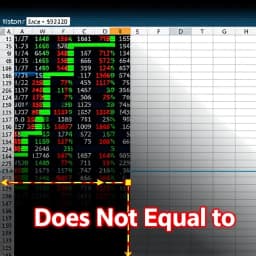
How to Write Does Not Equal in Excel
Find this useful? Bookmark ( CTRL/CMD + D ) for quick access!
Try an example:
Basic Formula Usage
Data Validation Checks
Conditional Formatting
Filtering Data Sets
Error Checking in Formulas
Comparative Analysis
Explore Similar Tools
Recent Generations
the amount paid directly to you. Yes it is possible in future cases to request direct payment to the provider, Rephrase and give me polished email.
we have processed the claim as per the attachments in the claim submission we have processedthe invoice for Saul Holding. We dont have invoice for the Salofalk.
this additional information is very important. this adiitional information was requested by our clinical team. Without clinical review claim not be paid so please share the below additional information
How To Write Does Not Equal In Excel
How To Write Does Not Equal In Excel is a powerful AI-powered guide that helps users understand the intricacies of using the "not equal to" operator in Excel. This innovative solution combines step-by-step instructions with practical examples to deliver clarity and confidence in data analysis tasks.
Key Capabilities
- Comprehensive Tutorials: Offers detailed explanations on how to use the "not equal to" operator, ensuring users grasp the concept thoroughly.
- Practical Examples: Provides real-world scenarios and examples that demonstrate the application of the "not equal to" function in various Excel tasks.
- User-Friendly Interface: Features an intuitive layout that makes it easy for users of all skill levels to navigate and find the information they need.
- Quick Reference Guides: Includes handy tips and shortcuts for using the "not equal to" operator efficiently, saving users time and effort.
Who It's For
Designed for Excel users ranging from beginners to advanced analysts, How To Write Does Not Equal In Excel excels in enhancing data manipulation skills. Whether you're a student working on assignments or a professional analyzing datasets, this tool streamlines your learning process and boosts your productivity.
Why Choose How To Write Does Not Equal In Excel
What sets How To Write Does Not Equal In Excel apart is its focus on practical application and user engagement, making it the ideal solution for anyone looking to master Excel functions and improve their data analysis capabilities.
Ready to transform your Excel skills? Start using How To Write Does Not Equal In Excel today and experience the difference in your data analysis tasks!
Enhance Your Work with How to Write Does Not Equal in Excel
Leverage the power of AI to streamline your tasks with our How to Write Does Not Equal in Excel tool.
Step-by-Step Guidance
Receive detailed instructions on how to use the 'Does Not Equal' function in Excel, ensuring you understand each step.
Formula Examples
Access a variety of practical examples and templates for using the 'Does Not Equal' function in different scenarios.
Interactive Support
Get real-time assistance and tips while working in Excel, helping you troubleshoot and optimize your formulas.
How How to Write Does Not Equal in Excel Works
Discover the simple process of using How to Write Does Not Equal in Excel to improve your workflow:
Input Your Data
Begin by entering your data into the Excel spreadsheet where you want to apply the 'Does Not Equal' condition.
Select the Range
Highlight the range of cells you want to analyze for the 'Does Not Equal' condition.
Apply the Formula
Use the formula '!= value' to filter or conditionally format the cells based on your criteria.
Review Results
Examine the results to ensure the 'Does Not Equal' condition has been applied correctly and adjust as necessary.
Use Cases of
How to Write Does Not Equal in Excel
Explore the various applications of How to Write Does Not Equal in Excel in different scenarios:
Data Validation
Ensure data integrity by using the 'Does Not Equal' function to identify and flag discrepancies in datasets.
Conditional Formatting
Apply conditional formatting rules to highlight cells that do not match a specified value, improving data visualization.
Error Checking
Utilize the 'Does Not Equal' function to quickly identify errors in data entry or calculations, enhancing accuracy.
Filtering Data
Filter out unwanted data entries in large datasets by using the 'Does Not Equal' criteria, streamlining data analysis.
Who Benefits from How to Write Does Not Equal in Excel?
AI-Powered Efficiency
From individuals to large organizations, see who can leverage How to Write Does Not Equal in Excel for improved productivity:
Data Analysts
Utilize advanced Excel functions to enhance data analysis and reporting capabilities.
Software Developers
Integrate Excel functionalities into applications for improved data handling and logic implementation.
Students
Learn essential Excel skills for academic projects and data management tasks.
Project Managers
Track project metrics and performance indicators using effective Excel formulas.
Frequently Asked Questions
What does 'Does Not Equal' mean in Excel?
'Does Not Equal' in Excel is represented by the operator '<>'. It is used in formulas to compare two values and returns TRUE if they are not equal and FALSE if they are equal.
How can I use 'Does Not Equal' in an Excel formula?
You can use 'Does Not Equal' in Excel formulas by incorporating the '<>' operator. For example, the formula =A1<>B1 will return TRUE if the values in cells A1 and B1 are different.
Can I use 'Does Not Equal' in conditional formatting?
Yes, you can use 'Does Not Equal' in conditional formatting rules. When setting up a rule, you can select 'Use a formula to determine which cells to format' and use a formula like =A1<>B1 to apply formatting based on the condition.
Is 'Does Not Equal' case-sensitive in Excel?
No, the 'Does Not Equal' operator in Excel is not case-sensitive. It treats 'apple' and 'Apple' as equal when comparing text values.
What are some common use cases for 'Does Not Equal' in Excel?
Common use cases for 'Does Not Equal' include filtering data, validating entries, creating conditional formatting rules, and performing logical tests in complex formulas.
































